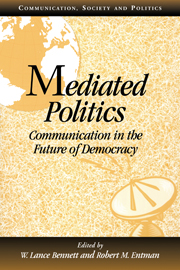Book contents
- Frontmatter
- Contents
- List of Figures
- List of Tables
- Contributors
- Preface
- Acknowledgments
- 1 Mediated Politics: An Introduction
- Part 1 Democracy and the Public Sphere
- Part 2 Citizens, Consumers, and Media in Transition
- Part 3 Mediated Political Information and Public Opinion
- 10 Reframing Public Opinion as We Have Known It
- 11 Political Waves and Democratic Discourse: Terrorism Waves During the Oslo Peace Process
- 12 Monica Lewinsky and the Mainsprings of American Politics
- 13 The Big Spin: Strategic Communication and the Transformation of Pluralist Democracy
- 14 The Impact of the New Media
- Part 4 Mediated Campaigns
- Part 5 Citizens: Present and Future
- Index
11 - Political Waves and Democratic Discourse: Terrorism Waves During the Oslo Peace Process
Published online by Cambridge University Press: 05 June 2012
- Frontmatter
- Contents
- List of Figures
- List of Tables
- Contributors
- Preface
- Acknowledgments
- 1 Mediated Politics: An Introduction
- Part 1 Democracy and the Public Sphere
- Part 2 Citizens, Consumers, and Media in Transition
- Part 3 Mediated Political Information and Public Opinion
- 10 Reframing Public Opinion as We Have Known It
- 11 Political Waves and Democratic Discourse: Terrorism Waves During the Oslo Peace Process
- 12 Monica Lewinsky and the Mainsprings of American Politics
- 13 The Big Spin: Strategic Communication and the Transformation of Pluralist Democracy
- 14 The Impact of the New Media
- Part 4 Mediated Campaigns
- Part 5 Citizens: Present and Future
- Index
Summary
The modern political process can be thought of as a series of cycles in which leaders, publics, and the press focus attention on a narrow number of public issues and events for a limited period of time. The initiation of these cycles, or political waves, is marked by a dramatic increase in media coverage about an issue, an increase in public reactions by political leaders and activists concerning the topic, and an increase in discussions about the issue among the general public (Downs 1972; Hilgartner and Bosk 1988; Linsky 1991; Mathes and Fetch 1991; McCombs and Hua 1995). After reaching a certain peak in public attention, such waves either die of their own accord or are replaced by new waves. The study of these waves can provide important insights into a wide range of issues that confront researchers in the fields of political science, communication, and sociology.
Political waves can be defined as sudden and significant changes in the political environment that are characterized by a substantial increase in the amount of public attention centered on a political issue or event. Whereas this is the first time that the term political wave is being used in the literature, it is important to carefully specify its meaning.
The first thing to note is that the unit of analysis is the political environment. The political environment refers to the aggregate of private and public beliefs, discourse, and behaviors concerning political matters within a particular setting and time (Wolfsfeld 1997a). It is a “macro” concept referring to the political “situation” at a given time and place.
- Type
- Chapter
- Information
- Mediated PoliticsCommunication in the Future of Democracy, pp. 226 - 251Publisher: Cambridge University PressPrint publication year: 2000
- 1
- Cited by



